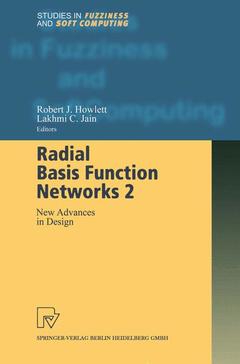Description
Radial Basis Function Networks 2, Softcover reprint of the original 1st ed. 2001
New Advances in Design
Studies in Fuzziness and Soft Computing Series, Vol. 67
Authors: Howlett Robert J., Jain Lakhmi C.
Language: English
149.99 €
In Print (Delivery period: 10 days).
Add to cart
Radial basis function networks 2
Publication date: 03-2011
360 p. · 15.5x23.5 cm · Paperback
Publication date: 03-2011
360 p. · 15.5x23.5 cm · Paperback
149.99 €
Subject to availability at the publisher.
Add to cart
Radial basis function networks 2: new advances in design (POD)
Publication date: 03-2001
Support: Print on demand
Publication date: 03-2001
Support: Print on demand
Description
/li>Contents
/li>Comment
/li>
The Radial Basis Function (RBF) network has gained in popularity in recent years. This is due to its desirable properties in classification and functional approximation applications, accompanied by training that is more rapid than that of many other neural-network techniques. RBF network research has focused on enhanced training algorithms and variations on the basic architecture to improve the performance of the network. In addition, the RBF network is proving to be a valuable tool in a diverse range of applications areas, for example, robotics, biomedical engineering, and the financial sector. The two-title series Theory and Applications of Radial Basis Function Networks provides a comprehensive survey of recent RBF network research. This volume, New Advances in Design, contains a wide range of applications in the laboratory and case-studies describing current use. The sister volume to this one, Recent Developments in Theory and Applications, covers advances in training algorithms, variations on the architecture and function of the basis neurons, and hybrid paradigms. The combination of the two volumes will prove extremely useful to practitioners in the field, engineers, researchers, students and technically accomplished managers.
1. An overview of radial basis function networks.- 2. Using radial basis function networks for hand gesture recognition.- 3. Using normalized RBF networks to map hand gestures to speech.- 4. Face recognition using RBF networks.- 5. Classification of facial expressions with domain Gaussian RBF networks.- 6. RBF network classification of ECGs as a potential marker for sudden cardiac death.- 7. Biomedical applications of radial basis function networks.- 8. 3-D visual object classification with hierarchical radial basis function networks.- 9. Controller applications using radial basis function networks.- 10. Model-based recurrent neural network for fault diagnosis of nonlinear dynamic systems.- List of contributors.
Contains a wide range of applications in the laboratory and case studies describing current use Overall view of the methods used for the genetic optimization of artificial neural networks and presentation of the inherent problems Includes supplementary material: sn.pub/extras
© 2024 LAVOISIER S.A.S.




